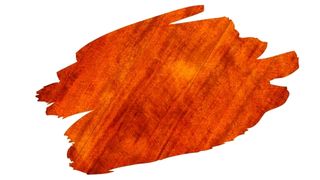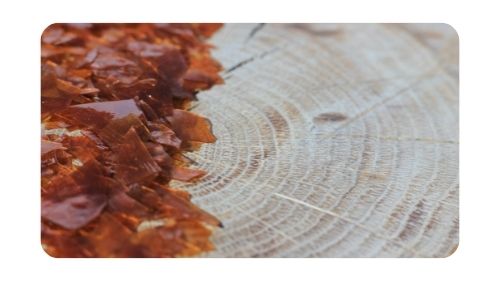Danish oil really does look great, doesn’t it!
This finish just has its own a way of making otherwise dry wood grain suddenly look nourished and natural – all with a satin flourish.
But, while Danish oil can preserve wood by safeguarding it from moisture, it isn’t really a complete protective finish.
If you’ve used Danish oil on something that might see a bit of wear and tear – and the odd water spill – then that oil finish will definitely need a top sealant coat.
Now, a popular sealant product is shellac. Sure, it’s not as fashionable as more durable sealers such as polyurethane or epoxy resin.
But still, this naturally sourced stuff does a great job at stopping leaky resins. Basically, you coat shellac over wood knots, and you won’t need to worry about any of that wood resin bleeding through.
However, shellac isn’t great at keeping water from getting in underneath the surface. In fact, shellac is easily susceptible to water damage – and it doesn’t offer that much more waterproofing than just a Danish oil finish alone.
So, can you really apply shellac over Danish oil?
If you apply a dewaxed shellac coat over a fully cured Danish oil finish, then the two will bind together perfectly well.
And if you want to give that satin Danish oil coat a high gloss finish, then look no further than shellac.
Shellac can give that color tinted oil a sheen that’ll enhance that grain pattern. Especially when used on decorative wood crafts, such as side tables and jewellery boxes.
But, you are better off not using shellac as your sealant of choice on wooden surfaces that will likely see a lot of water spills and/or scratches (such as kitchen tables).
However, it is worth repeating that the shellac needs to be dewaxed (not waxed) if you want it to stick. And that Danish oil needs to be not just dry but also cured if you want that shellac to stay on.
And here’s why…

This post may contain affiliate links to products that we receive a commission for (at no additional cost to you). Learn more here.
Can You Put Shellac Over Oiled Wood?
If that shellac is waxed shellac, then no you can’t. The wax in this shellac substance won’t stay on anything… least of all an oiled surface.
Which is why it is so important to use a dewaxed shellac product. And what makes this stuff so special? Well, it’s in the name… its been dewaxed.
With the wax removed, shellac is like a whole different product; it’ll stick to just about anything. Wood, concrete, glass… you name it, and it will adhere to it.
Can Shellac Be Wiped On? You can wipe on shellac using what is referred to as a ‘padding technique‘. This involves using a 2 inch square folded yet soft cloth to wipe on the shellac in a brushing motion.
So, Can You Use Dewaxed Shellac Over Danish Oil Any Time?
Yes, you can, but with one caveat… that Danish oil needs to be cured through first.
Drying oil finishes (like Danish oil, Linseed oil and Tung oil) go through a two step process; Drying and then Curing.
These two terms (often used interchangeably) actually refer to two very different processes:
Dry Danish Oil
When Danish oil dries, it has turned from a wet liquid into a soft, yet solid, film. This process usually doesn’t take too long, depending on the brand of Danish oil.
It can take anywhere from 24 to 48 hours for Danish oil to dry. But, something like Watco Rust-Oleum Danish Oil Wood Finish can dry in as little as 4 hours.
You can check out the latest price for Watco’s Danish oil over on Amazon.
Cured Danish Oil
When we say that Danish oil has cured, we’re describing a chemical process that has turned the solid film into a hard resin. It is not just dry, but it is also durable – both on the surface and beneath it too.
Now, you can easily test whether or not oil is simply dry – all that takes is a swipe of your finger.
However, you can’t properly check to see if oil has fully hardened underneath that wooden surface. Making it difficult to tell if a wood finish has completely cured.
But, as a general rule of thumb, the curing process can take up to 30 days to complete (albeit longer in colder or high humidity climates).

Why Waiting For Danish Oil To Cure Really Matters
If that oil finish is still soft and tacky, and you wipe shellac onto it, you could wiping some of the oil finish off.
Long story short; wait for Danish oil to complete its job and cure right through. Afterwards, you can apply shellac to your hearts content.
What Finishes Can Be Applied Over Danish Oil? Polyurethane, Shellac, and Lacquer all work nicely over a Danish oiled finish.
Related Post: Can You Apply Epoxy Over Danish Oil? (Best Practice Revealed)
Let’s Wrap Things Up…
As long as that shellac product has been dewaxed – and that oil finished has wholly cured through – then you can coat shellac over Danish oil.
It wont slide off the oil finish at all, quite the opposite. And once done, it should give Danish oil’s otherwise satin appearance a more eye-catching gloss.



![Why Are There Bubbles In My Shellac Wood Finish? [+ How To Get Rid Of Them] bubbles in shellac wood finish](https://www.thewoodworkplace.com/wp-content/uploads/2022/10/Banner-499-150x150.jpg)